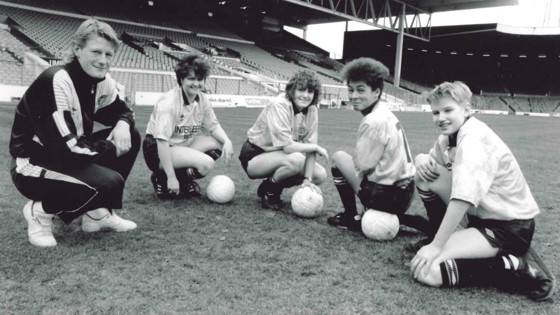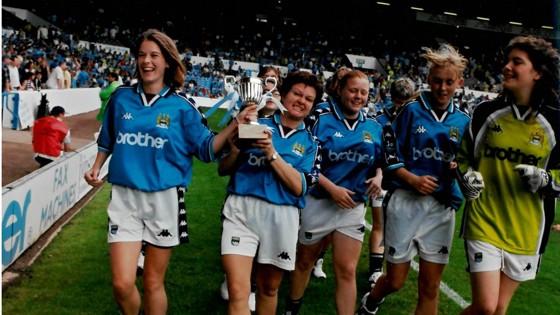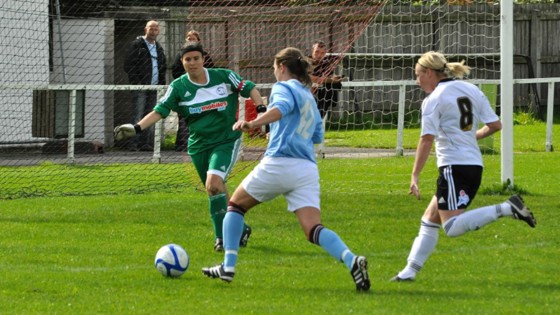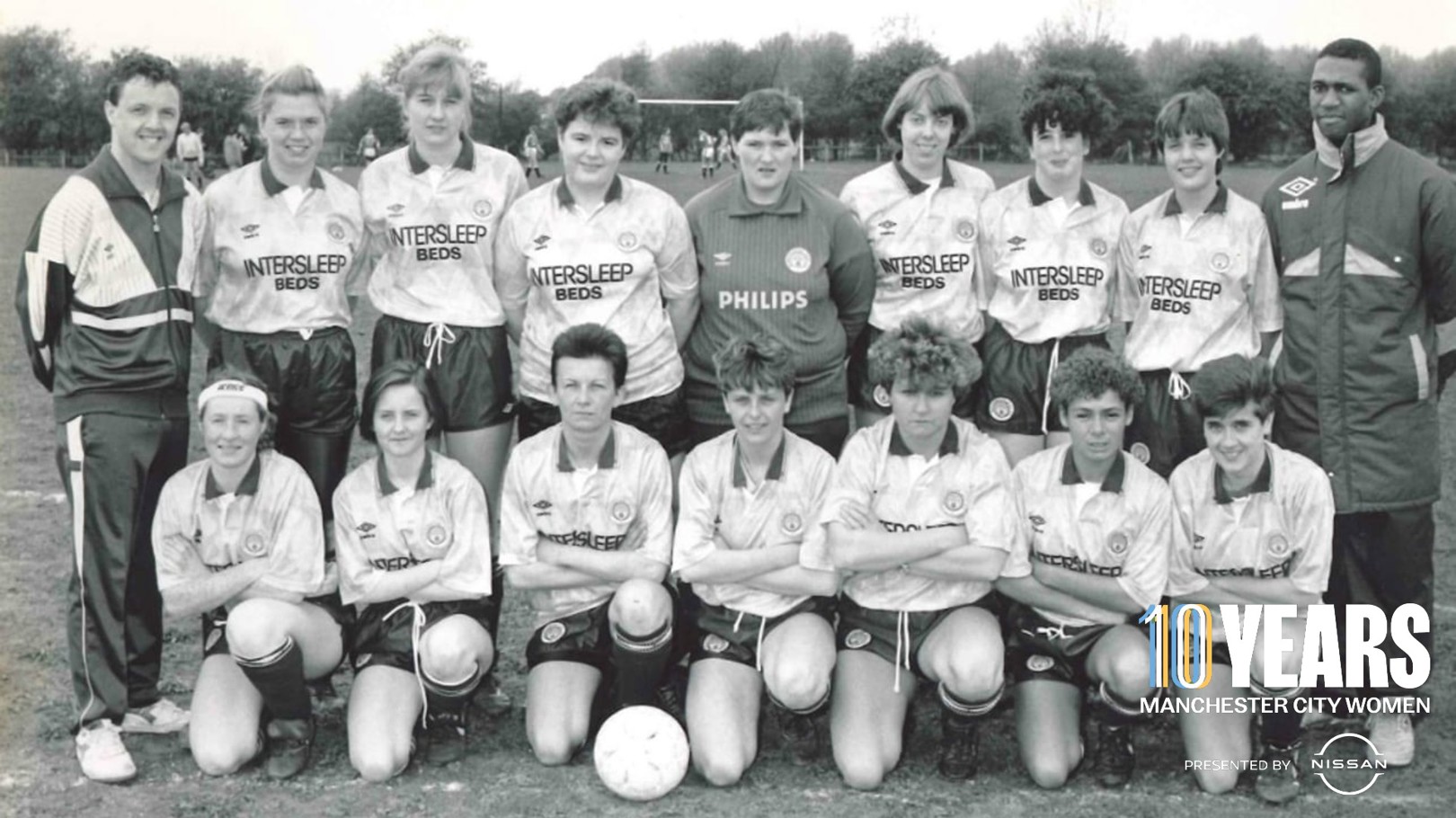Indeed, Friday 24 January 2014 marked the beginning of a new era for the Club, with our first-ever professional side relaunched at an Etihad Stadium event.
A decade on, City can be equally proud of what we’ve been able to achieve both on and off the pitch, and excited by what the future holds.
However, to not acknowledge the tireless work of our original Ladies team, formed over three decades ago, would be a disservice to those who continually and proudly banged the drum for Women’s football.
That story begins on Sunday 27 November 1988, when a women’s City side first took to the pitch at Boundary Park to face Oldham Athletic.
Neil Mather – founder of the team who worked for City in the Community – had been holding training sessions for around six weeks ahead of the fixture following the success of several women’s-only five-a-side tournaments.
Speaking in 2018, he revealed some of his amusing recollections from that fixture against Oldham.
“Oldham were kitted out in long-sleeve kits, while we only had the youth team kit, which was huge!
“The players were complaining about the cold but I told them: it’s all in the psychology. You can’t be cold if you’re moving around!
“There was some amusement when one of our coaches John Fox kept shouting: ‘Carry!’ and the players (who didn’t really know each other that well) kept turning to ask who Carrie was.
“’No, carry the ball’ cried John at half-time, amidst the confusion. You can laugh now!”

One of the players to feature for City on that day was Rowena Foxwell, who would go on to become a crucial figure in the team’s early years.
She tragically passed away in January 2019 but is remembered fondly for her tireless efforts to put the Club on the map.
Speaking to Gary James in 2018 for his book Manchester City Women: An Oral History, she reflected: “It was so rapid, I can’t remember how we got to the game in the sense of from that first session to how it became a team.
“I don’t think I’ve analysed it, because I was too young to know any different. At that age you just do it, but we were playing on a proper pitch, and using proper dressing rooms!
“We were excited, definitely. Now you’d look back and think about it more. My youngest son is in awe: ‘You played football? You played for City?’”
A brace apiece from Donna Haynes and Heidi Ward would see us run out 4-1 winners on Oldham’s famous plastic pitch, which would host top flight matches within three years of the watershed fixture.
Club historian Gary James was watching on the terraces that day, but doesn’t think the playing surface made too drastic an impact on City, especially considering the pitches they were used to playing on.
“It wasn’t as alien as it seems, and it was far superior to some of the muddy pitches they’d had to play on,” he insists.
“Yes, the bounce was weird and all that, but my overwhelming feeling from that game was that every player seemed to be enjoying the fact they were in a stadium which could hold just over 20,000 at the time.
“Yes, it’s a plastic pitch but it was streets ahead of playing in whichever park it may have been. It elevated it and made it feel special.”
CITY+ | SUBSCRIBE TO ACCESS EXCLUSIVE CONTENT
As Gary alludes to, the game’s significance went far beyond the result, performance or any amusing anecdotes.
Interest in the newly-formed City side was on the rise, with the team playing several friendly matches over the following months as they continued to grow and develop as a unit.
Lesley Wright was one such player to join the team a few weeks after that first fixture against Oldham.
And while some of the details from that early period might have been lost, the pride of representing the Club she supported remains as strong as ever.
“The pictures bring back memories – the pitch has been rutted, it’s cold, one man and his dog on the side, the kit was the white one with very thin stripes down.
“I can’t even remember what the score was but for me, just being able to play football at a time when most people thought women shouldn’t, or couldn’t, was special.
“Being part of a team that I love and support was the best thing ever for me.”

Gail Redston would go on to represent City for almost 15 years. In her own words, she’d had a ball at her feet since she was ‘knee high to a grasshopper’, featuring for trailblazing women’s team, Manchester Corinthians.
She hung her boots up after starting a family but, like Lesley, the lure of playing for City was too tantalising.
“It was one of my brothers,” Gail explains when asked how she heard about our first women’s team.
“He saw an advertisement in the paper which said City were starting a Ladies team. So, I trotted off down to Platt Lane, had trials and it just went from there.
“At first because there were so many, it wasn’t the greatest of standards.
“But once Neil [Mather] had us all established and we entered the league the year after, we started to attract other players.”
City would join the North West League Second Division in 1989, meaning those who had been playing competitive football for local sides such as Redstar and Corinthians alongside the Club now had a decision to make.
Players were unable to represent two sides who were competing in the league pyramid, meaning Neil Mather had to worry about potentially losing the team he had worked so hard to build.
It turned out to be the opposite in most situations though, with diehard City fans committing to the upstart side ahead of our first competitive season.
“There were City fans in the team I was playing for at the time, and they were aware of the community initiative to get a Ladies team,” Rita Howard, who would go on to captain and become team’s first female manager, reflects.
“They were committed to joining, so I followed suit really, it was a friendship decision. I’d been playing with them since I was 12 and want to continue to do so.
“I moved and was ever so grateful that I did in the end. I hadn’t known about the first game, or I just have a rubbish memory!
“[But] as a collective we got better and better with the coaching and all that was available to us.”

Despite some high points at the beginning of the decade, and a rebuild at the turn of the millennium, the 1990s was generally a difficult period for City.
Nonetheless, the support for our Women’s team continued, with Colin Hendry named Ladies Team President in March 1990. Club legends such as Alex Williams, Tony Book and Glyn Pardoe, to name just a few, also helped source kit and a minibus for the team.
Gestures such as this might seem small, but they were of huge significance at the time and a massive boost to the team, as we gained another promotion in 1992.
“I can remember Alex Williams giving me one of his shirts, the Phillips one,” Anita Clarke adds.
“I actually started playing out because we already had a goalkeeper.
“There was no keeper for one game though, so I said I’d go in. I’ve stayed in since then.
“I used to play right-back and enjoyed it, but once I’d gone in net and had a taste of it, it felt like it was for me.”
WSL TICKETS: BUY YOURS TO CHEER ON CITY
By the turn of the millennium, City were on a roll, and gained three promotions between 1998 and 2001 to sit in the second tier of English football, our highest position since our first competitive seasons back in the late 80s.
It was an exciting time to be a Blue, with our Men’s team beginning the climb back up to the top flight under the guidance of Joe Royle and then Kevin Keegan.
A Cup double in 2000 provided yet another memorable moment for our Women’s team, but to turn out against Manchester United at Maine Road as part of a UNICEF Charity match a year later was the icing on the cake.

“It was superb,” Redston remembers.
“We were itching to get out and the manager was just saying ‘hang fire for a bit’.
“What had happened was that United were giving us a guard of honour for winning the league that year, which made it even more special.”
After fighting at the wrong end of the table for a few years following promotion, the team began to gradually work our way up the second tier.
Indeed, City finished in the top four in three successive seasons between 2008/09 and 2010/11, before the restructuring of the Women’s Super League saw the FA National Northern Division become the third tier.
However, the Blues would respond in style, winning the title in 2011/12 by five clear points.
Our solitary season in the FA National Division, the new second tier, before our professional relaunch would also yield a highly respectable fourth-placed finish.
Chelsea Nightingale was part of that promotion-winning season in 2012 having joined the Club from Manchester United’s youth ranks a few years prior.
“We had a really good bunch of players, and we had consistency with the squad,” the defender recalls.
“In my first full season with the team, we went up into FA Women’s Premier League North and that’s when we first got wind of City really coming on board.”
Nightingale alludes to the formalisation of the relationship between the Club and the Ladies team in 2012, with the application process for the WSL beginning in the following months.

She continues: “To begin with, it didn’t feel like much changed and we had a reasonably good first season in the Premier League.
“It felt like a slow process at first, we were told the plans and the whole team went through a couple of months of trials for the original team, and bringing the new signings in.”
Key signings such as Steph Houghton, Jill Scott, Karen Bardsley, Toni Duggan and Izzy Christiansen pulled back the curtain on a new era for the Club, but Nightingale was one of several members of our Ladies team to form part of that first professional side in 2014.
With those five signings training full-time and the rest of the squad joining for an evening pitch session, it was a difficult transition to adapt to initially.
However, as Nightingale explains, the vision was something which she and her team-mates fully bought into.
“It was a massive achievement to be part of that team, and I loved every minute of it. Training full time, moving across to the CFA and just putting City’s Women’s team on the map.
“Don’t get me wrong, it was hard work and long days still as I went to full-time training with the team and part time working, so my days were 8am-8pm Monday-Friday with game preparation on the weekends. It was non-stop, but I wouldn’t change the experience.”
Unfortunately, a cartilage issue cut Nightingale’s time with City short, but she continues to work with the Club as part of her work as a Soft Tissue Therapist.
And those bonds remain as strong today as they were over three decades ago for many of the players.
Indeed, the likes of Gail Redstone, Lesley Wright, Heidi Ward and Anita Clarke are just a few of the players who represent our Women’s Walking Football team, a joint venture between the Club and CITC.
“Gail [Redstone] rang me and said City are doing walking football and we need a keeper,” she recalls.
“I hadn’t played for 20 years but we started playing for CITC, go to tournaments and represent City at that.
“There’s still that core of the England over-55s team, it’s just City mainly. It’s only seven-a-side and a fair few are City players!”
Lesley continues: “I go to walking football at the academy and sometimes I go down to the tennis centre.
“We’re still able to play the game at the place. City were so good to us.
“So now to see where the game is, I’m glad. I’m so pleased with where it is.”







